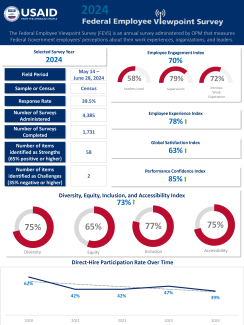The Federal Employee Viewpoint Survey measures employees' perceptions of their agencies and is a management tool to drive change and increase employee engagement in the federal workforce. USAID's leadership is committed to using the results to help better achieve our Agency's mission and to make USAID a great place to work. Recruiting and retaining the best and the brightest individuals depend, in large part, on the quality of the work environment.

An official website of the United States government
Here's how you know
The .gov means it’s official.
Federal government websites often end in .gov or .mil. Before sharing sensitive information, make sure you’re on a federal government site.
The site is secure.
A lock () or https:// ensures that you are connecting to the official website and that any information you provide is encrypted and transmitted securely.
